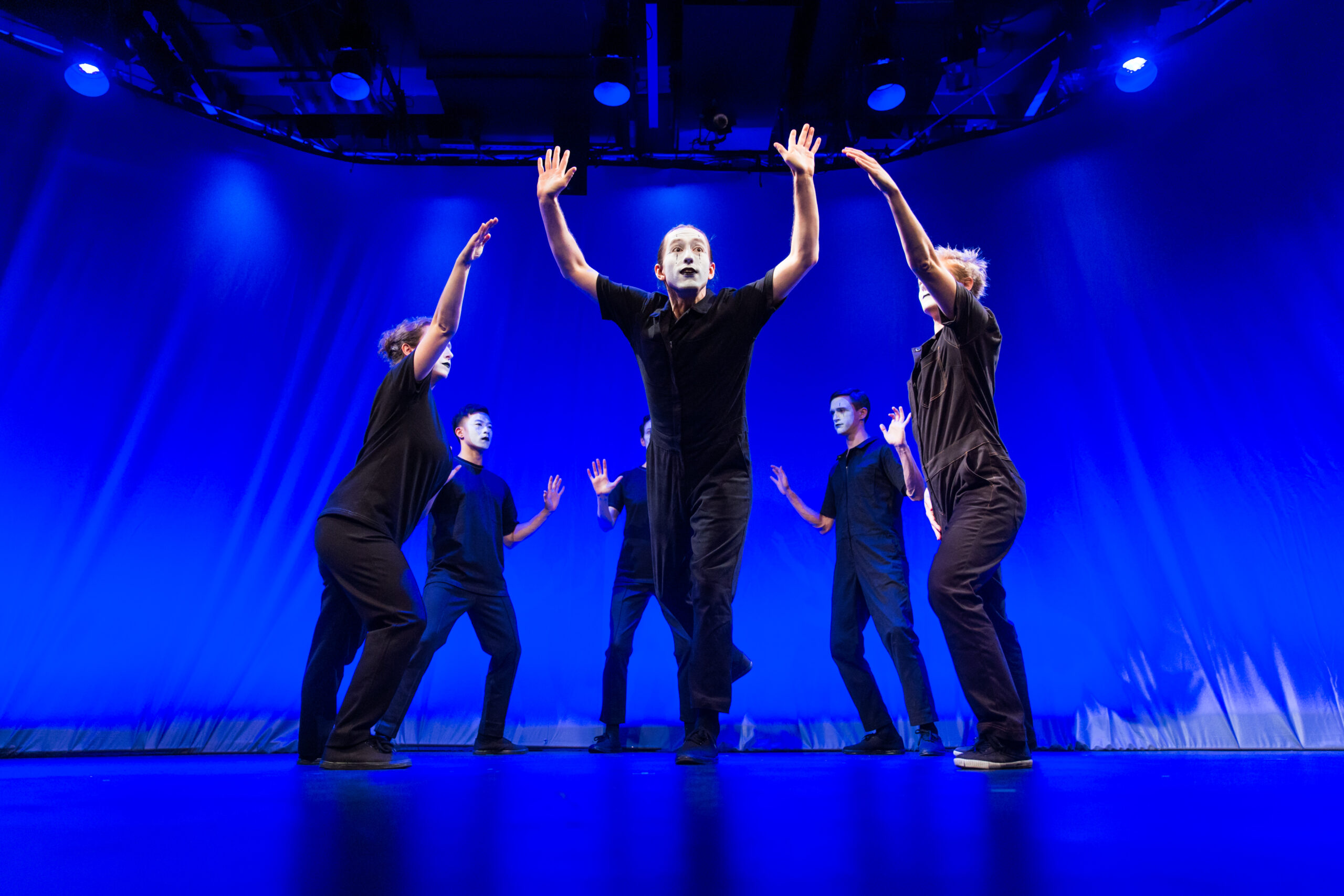
The Broken Box Mime Theater’s 2022 performance of “Take Shape.” (Credit: Bjorn Bolinder, courtesy of Find The Light Photography)
On a Sunday afternoon in the Garment District, a theater company drew “oohs” and “aahs” from a roomful of children — without ever saying a word.
With five actors on a bare stage, the performers created a world that required only imagination. The actors were dressed in black clothes and white face paint, and quickly became zombies, then waddling penguins, then a Super Mario Brothers video game, without a prop or costume change.
Between scenes, the artistic director, Becky Baumwoll, walked on stage and created a call-and-response with the young audience using hand gestures. The weekend’s audience, Baumwoll later revealed, included Uyghur Muslim and Ukrainian refugee families. Despite the language barriers, the children laughed together.
That Sunday, artists at Broken Box Mime Theater were performing their November Stories Beyond Show: a languageless performance geared toward families. Baumwoll and company organized the show in partnership with the International Rescue Committee. The performance was entirely nonverbal, which Baumwoll designed with refugee and asylum-seeking youth in mind. Another perk? The show was free.
Broken Box Mime Theater provides live performances throughout the year at a low cost to audiences of all ages. Through its commitment to inclusion and unique, wordless storytelling, Broken Box and other New York-based mime artists are breaking misconceptions about mime and proving how the medium can be an effective tool for activism and emotional storytelling.
Thinking Outside The Broken Box
“In mime, there’s a heightened awareness of what the body can say, and a message that the body is a beautiful storyteller that communicates all the time,” said Baumwoll over coffee in Brooklyn. “It’s empowering.”
Baumwoll and her co-founder, Tasha Milkman, first encountered mime while undergraduates at Tufts University, where they joined a student-run mime club, “HYPE!” After graduating and moving to New York, Baumwoll and Milkman founded Broken Box Mime Theater together in 2011.
Broken Box has twenty company members and three paid staffers. They organize programs for all ages and backgrounds. In addition to live performances, Broken Box also organizes educational workshops at every grade level and pay-what-you-can masterclasses.
“Overall, in mime, I find that the audience really leans in,” said Milkman, who is Broken Box’s associate artistic director. “There’s a more intimate relationship between the audience and the performer because the audience really has to invest their own imagination in the story.”
The organization, which has been running as a non-profit since 2014, survives mostly off grants and fundraiser events throughout the year, according to tax records. In order to remain accessible to the public, Baumwoll revealed that Broken Box relies on private donations more than a typical commercial New York production.
“There’s just a whole lot of different kinds of scraping together that you got to do,” she said.
Even with a limited budget, the Stories Beyond Show in November delighted, with the children in the audience erupting in high-pitched laughter and the occasional cough. The performers leaned into mime’s reputation as a fundamentally silly undertaking.
“Spooky, weird,” said Lilia, 6, who experienced her first ever mime show with her babysitter.
Amelia Byng, also 6, said her favorite part of the show was “When they do blublublu,” mimicking the performer’s over-the-top arm movements.
But shows for adult audiences often carry a different tenor. Baumwoll described a piece titled “Variable.” Four mimes with visibly different identities act out the piece. The performance depicts a first date in which one person runs into an emotionally volatile ex, resulting in a violent outburst at the restaurant.
The scene repeats, with the actors having switched roles. “Now a small white woman is the one pushing instead of a large LatinX guy,” explained Baumwoll, “and it makes the audience say, ‘Broken Box is asking me to actually question my associations I have with the bodies of these people.’”
Previous Broken Box Mime Theater performances have also tackled serious themes. A 2017 scene called “Automatic” had the cast assembling invisible rifles onstage in a critique of gun violence in America. “Love Song” depicts the obstacles of refugee parents trying to find safety for their children in a new country.
Not only does the content of Broken Box performances often carry an activist message, but inclusivity is one of its core principles. The company’s “Inclusion & Accessibility” page lists a variety of practices which foster inclusion, such as “relaxed performances,” where the mimes modify the show for audience members with sensory issues.
“You’ve opened up that pathway for communication when you create a story that is political, or that asks the audience to really reflect and consider their own place in the world,” Baumwoll said. “The pathway is very open for some change, some transformation to happen.”
Turning Back The Invisible Clock
Mime activists did not simply sprout into being one day in a black-box theater in Midtown Manhattan. Mime is a longstanding art form with roots in antiquity.
“It’s the cross-pollination of lots of different theater forms,” said Seth Stewart Williams, professor of dance history and performance studies at Barnard University. “It’s a Greek word: Mimesis. The idea that you are representing something in a medium other than where it exists.”
The art of mime can be traced back to the Greco-Roman era, said veteran mime artist Nancy Lyon. Pantomime actors in ancient Rome communicated through exaggerated physical gestures because theaters were too large for actors to project their voices.
Centuries later, classical mime developed in postwar-era France, said Allen Kuharski, professor of theater at Swarthmore College. Pioneers like Marcel Marceau and Jacques Lecoq drew upon previous forms of non-verbal storytelling like Commedia Dell’Arte, Japanese Noh theater, and American silent film to create their own schools of performance in Paris.
As these mimes toured the world and founded schools and companies outside of France, their influence eventually rippled into American theatrical culture, according to Kuharski.
For example, Broken Box Mime Theater uses white masks, which “calls upon a specific performance tradition” of French mime, according to Milkman. Similarly, the company creates their scenes collaboratively, which echoes Lecoq’s teachings of collective creation.
“The performers all wearing the same thing gives us an indication to the audience not to read our individual characteristics, so much as to look at us as players,” explained Milkman.
Actions That Speak Louder Than Words
Mime allows the audience to interpret their own meaning by seeing the world from the perspective of the performer, which makes the medium a unique tool for activism.
“We are creating something that lets the audience create their own universe while they’re watching me,” said Gregg Goldston, 67, veteran mime artist and former student of Marcel Marceau. He spoke over Zoom from the study of his Manhattan apartment, which he had converted into a black-box theater.
Goldston founded his own mime school in Ohio and later served as the mime coach for actress Anne Hathaway on the film set of Enchanted. After a nearly fifty year career of performing, teaching, and directing mime, Goldston asserted that mime, like any other art form, can adopt a political purpose.
He rolled his chair back on the Zoom screen to provide an example. In the scene, Goldston played a character who finds it amusing to unscrew his fingers from his hands, only to watch them dance off the stage. The character continued removing his body parts in delight, watching as they crawled off the stage. Ultimately, his character became immobile and mutilated.
“I saw this as universal addiction, that I’m laughing as I’m killing myself,” said Goldston. He described how sees the act as a commentary on the decaying effects of addiction.
Similarly, Nancy Lyon, another former student of Marceau’s, developed a mimodrama called Dark Secrets in the late 1990s that tackled themes such as abortion, envy, and abuse. “It was about who we show ourselves to the outside versus who we are in our private lives,” said Lyon, who used masks to “highlight the conformity society demands of women.”
Lyon first performed the drama at a women’s event in her church in the late ‘90s, and then again at the Theater for the New City during the overturning of Roe v. Wade in the summer of 2022.
While mime performances might not always have a political message, Goldston mentioned how his French mime predecessors were sometimes also activists. Goldston’s mentor, Marceau, was a Holocaust survivor who rescued a number of orphans in Nazi-occupied France.
“He would make them all Fake IDs, they would hide them in their sandwiches, and they would pretend they were going on a picnic to get past the Germans and then leave the kids on the other side of the border of France,” Goldston said. He remembered Marceau emphasizing, “This is where I really learnt to act.”
Modern Mimes For Modern Times
Part of the goal of Broken Box Mime Theater is to reimagine and redefine mime for contemporary American audiences, according to the company’s website. This is a task that Baumwoll acknowledged can be difficult, given that not everyone takes mime seriously.
“Either people think of it as corny person in the park making fun of you, or they think of it as snobby self-involved training to become an artiste,” she said. “It became kind of a joke.”
As far as Baumwoll and Milkman are concerned, however, mime is neither about being pretentious nor hokey; it is about bringing audience and performers closer together.
Take the Monthly BKBX show in Williamsburg in late November. The two-hour show, geared toward adults, involved a scene that explored the experiences of a Korean immigrant lamenting about the challenges of adapting to American society. He applied white face paint in front of a mirror, symbolizing the “masks” we all wear to fit in.
The same show featured a Dungeons & Dragons piece that transformed a cast of gamers into daring heroes and monsters. Later, the mimes performed a scene where a groom loses his wedding ring and experiences a nervous breakdown. The audience applauded at serious and slapstick scenes alike.
“There’s laughter, there’s relatable moments, there’s sad moments, and they do a really good job of conveying all that in such a short amount of time,” Erikka James, 34, said after she watched the show. James first encountered mime through a 2019 Broken Box show. “I love the experience of not knowing what comes next,” she said.
“You think about mimes, you think it’s a funny joke thing, but you can actually have real emotions within the comedy,” echoed Breslin Logan, 27, a freelance musician and audio engineer who also attended the show. “There’s funny moments in real life, there’re sad moments in real life,” and while not all of the performances were serious, Logan emphasized, “they were all real.”
About the author(s)
Samuel Eli Shepherd, originally from Toronto, Canada, is a graduate student at the Columbia Journalism School.
Emma Paidra is part of Columbia Journalism School's graduating class of 2024, and she writes about culture and social justice.



